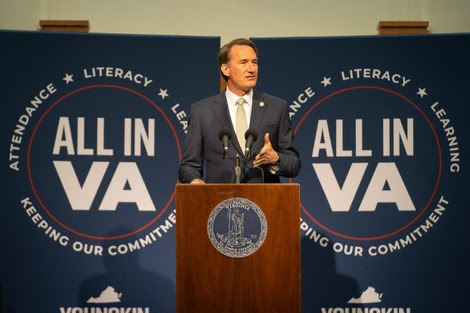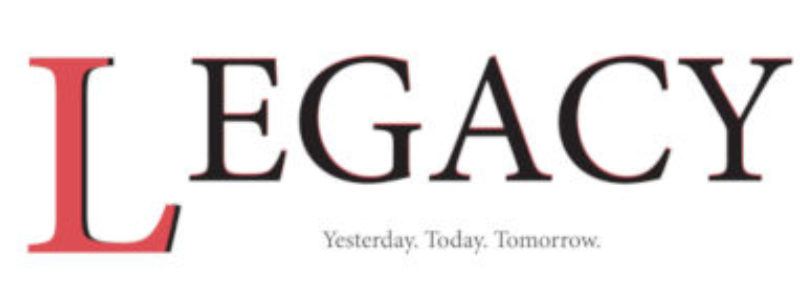By: Maria-Paula
Virginia students in Grades 3-8 showed some improvement in Math and Reading Standards of Learning testing in the school year 2023-2024. This followed the start of learning recovery from the extended pandemic school closures and the country’s most significant learning loss of students’ including the extensive work done by many Virginia educators.
Initiated by Governor Glenn Youngkin to improve attendance and accelerate literacy, Virginia’s ALL In Virginia initiative prioritizes learning in Virginia classrooms between the 3rd and 8th grades. Also, after intense focus from school divisions, parents, and community members as part of the project, Virginia’s K-12 chronic absenteeism rate has decreased by 16% since 2022-2023. In 2023-2024, 40,974 less students were chronically absent compared to 2022-2023.
“Since day one, our commitment to Virginia’s students has been a primary focus and last year, on a bipartisan basis, Virginia went ALL In to tackle core issues in K-12 education with basis on attendance, literacy and learning loss,” shared Governor Glenn Youngkin. “Virginia’s students and parents were facing the worst pandemic learning loss in the nation from Virginia being 46th in reopening in-classroom learning post pandemic. This is an ‘honesty gap’ between what the data told us, true student proficiency, and a systematic reduction of expectations by previous administrations on Virginia’s historically high academic standards. It’s clear our ALL In Virginia strategy is working, the signs are appearing and Virginia’s students and parents are benefiting from our collective efforts.”
Recognizing the work still needed to ensure every student is prepared and ready for life, Secretary of Education Aimee Rogstad Guidera shared the feeling that this year’s promising data showed that high expectations for students, teachers and schools, pushed them to meet targets when using proven approaches and tools.
“We know what works. Every school in the Commonwealth must know and understand each student’s academic progress and mastery as they provide tailored support and teaching that will put every student on track to succeed in life,” said Guidera.
Lisa Coons, Superintendent of Public Instruction, expressed pride in the number of teachers and educators who committed themselves to the ALL In high-intensity tutoring for the results achieved. Coons said putting proven measures in place this school year and having more resources available to students than ever before, including the Virginia Literacy Act being implementation spurred the growth.
“These results show that Virginia students are beginning to recover from the post-pandemic learning loss they suffered after 2020 and 2021. But the results also show that we must continue to focus every day on helping them catch up to pre-pandemic levels and move ahead,” said Coons.
In statewide Grades 3-8 Reading SOL results, 70% of school divisions showed student improvement in Reading SOL scores with 93 school divisions as 10.7% of school divisions maintaining their Reading SOL scores while 19.1% of school divisions showed decline in Reading SOL scores.
Statewide Grades 3-8 Math SOL results showed 75% improvement of school divisions in Math SOL scores with 99 school divisions. 4.6% of school divisions maintained their Math Reading SOL scores as 19.8% of school divisions showed decline in Reading SOL scores.
Math Statewide High School SOL results, high school students raised their SOL score to 84% in 2023-2024 from 81% in 2022-2023, seeing increased pass rates on all 3 high school math end-of-course exams.
High school students showed a slight decrease in SOL results with 84% of students passing in 2023-2024 versus 85% passing in 2022-2023 on the reading exam.
In science, high school students showed a 1% improvement in their SOL results rising to 71% in 2023-2024 from 70% in 2022-2023. This reflected increased pass rates on all 3 high school science end-of-course exams.
Although school division chronic absenteeism rates will be released later this fall, statewide K-12 Chronic Absenteeism Reduction Virginia’s K-12 schools show a 16% reduction in students who were chronically absent last year. The rate of chronic absenteeism fell to 16.1% in 2023-2024 from 19.3% in 2022-2023. All K-12 students had 1,276,522 fewer absent days, which resulted in an increase of 8,935,654 hours of instruction. Reinforcing the importance of regular school attendance, chronically absent students who attended less than 90% of the school year performed 19 percentage points below their peers in reading and 26 percentage points below in math.
Many student groups recorded an increase in their SOL Grades 3-8 pass rates, many rising faster than Virginia students overall. In Grades 3-8 Reading, economically disadvantaged students doubled the rate of growth of all student’s post-pandemic. English learners’ rate of growth in reading was more than 6 times the rate of growth of all students. Students with disabilities’ rate of growth in reading was 1.7 times the rate of growth of all students.
In Grades 3-8 Math, economically disadvantaged students more than doubled the rate of growth of all student’s post-pandemic. English learners on the other hand almost doubled their performance in math post-pandemic.
Students with disabilities’ rate of growth in math was 1.2 times the rate of growth of all students while Black students’ rate of growth was 3 times the rate of growth of all students.
Governor Youngkin called for all in Virginia to help the commonwealth’s students recover from extended pandemic school closures in response to 2022-2023 data showing persistent learning loss in Grades 3-8.
A $418 million multi-year initiative lasting through the 2025-2026 school year, ALL In encouraged school divisions to focus on four critical areas of learning supports including top of the list High-Intensity Tutoring where school divisions hired additional tutors, paid teachers stipends, and added more evidence-based tutoring during the school day.
In Extended Time, school divisions added hours before and after school schedules in addition to more time on Saturdays to provide students time outside of the school day for tutoring.
Summer Programs boosted learning focused on summer school hours and attendees, and some schools added days to the beginning and end of the school year. Many schools added additional at-risk students and expanded hours of programming to support learning recovery.
Resources being the fourth area of critical learning support focused on using the state’s free personalized supplemental math and reading resources. 119 out of the 131 school divisions have signed up to use one or more of these state’s free personalized resources in the school year 2024-2025.
ALL In VA also focused on confronting the issue of chronic absenteeism, which soared post-pandemic, with a Chronic Absenteeism Task Force, Action Kit for divisions, and proven strategies in reducing absenteeism, as well as accelerating the implementation of the Virginia Literary Act. The act brings effective instructional strategies grounded in evidence-based reading research to Virginia classrooms statewide and is being implemented in Grades K-3 this school year.
Gov. Youngkin: Students recovery post pandemic learning loss



